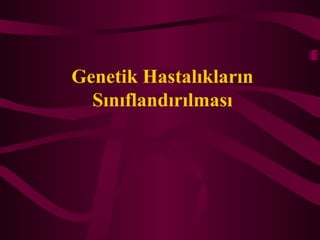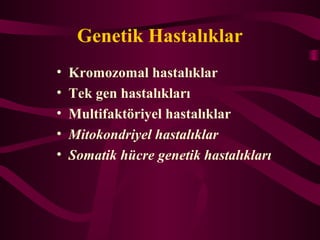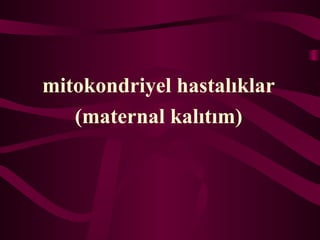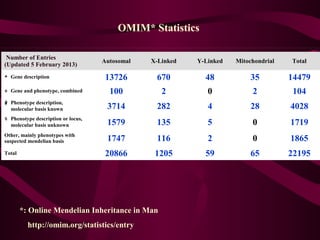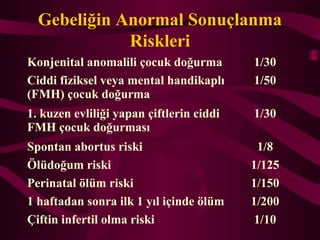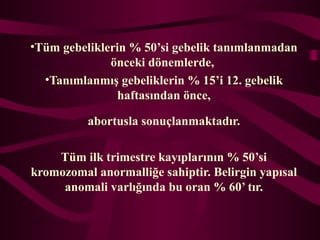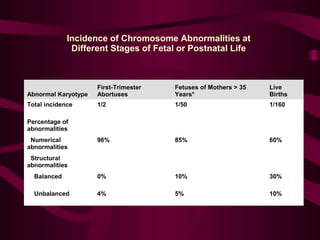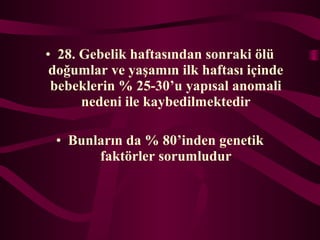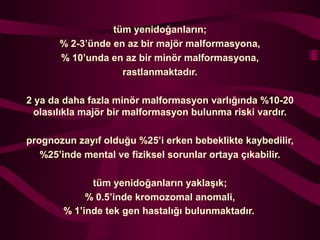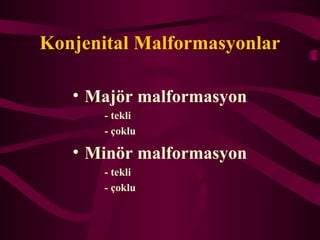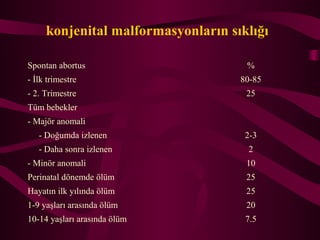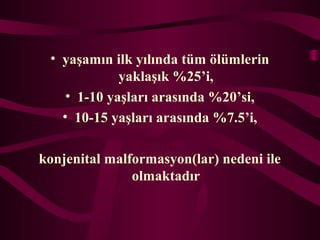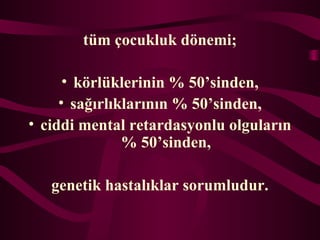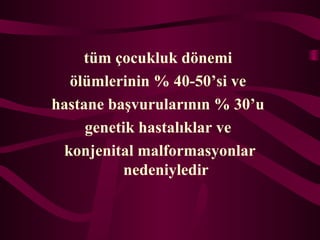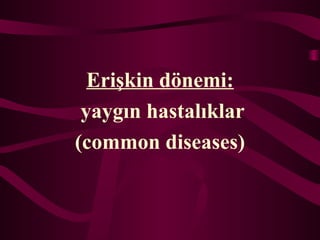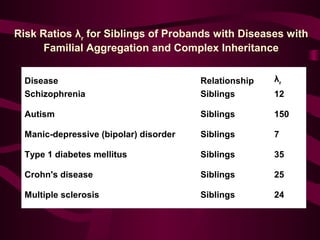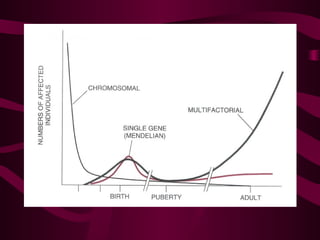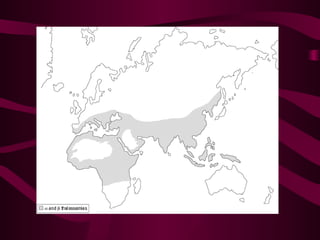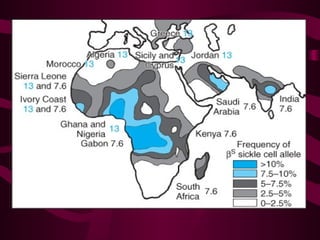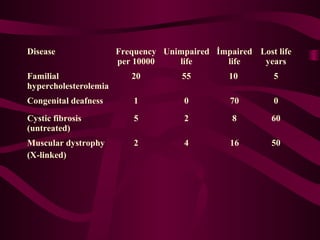Genetikhastaliksiniflandirma
- 2. Genetik Hastal?klar ? Kromozomal hastal?klar ? Tek gen hastal?klar? ? Multifakt?riyel hastal?klar ? Mitokondriyel hastal?klar ? Somatik h©╣cre genetik hastal?klar?
- 3. Kromozomal Hastal?klar ? Say?sal ©C An?ploidi ©C Poliploidi ? Yap?sal ©C Translokasyon ©C Delesyon ©C ?nversiyon ©C Duplikasyon ©C Ring ©C ?zokoromozom
- 4. Tek Gen Hastal?klar? ? Otozomal dominant ? Otozomal resesif ? XĪ»e ba?l? dominant ? XĪ»e ba?l? resesif ? YĪ»ye ba?l? ?
- 5. Multifakt?riyel Hastal?klar Birden fazla gen ve ?evresel fakt?rlerin etkile?imi sonucu ortaya ??kan hastal?klard?r. ? konjenital malformasyonlar ? eri?kin d?nemi yayg?n hastal?klar?
- 8. Number of Entries (Updated 5 February 2013) Autosomal X-Linked Y-Linked Mitochondrial Total * Gene description 13726 670 48 35 14479 + Gene and phenotype, combined 100 2 0 2 104 # Phenotype description, molecular basis known 3714 282 4 28 4028 % Phenotype description or locus, molecular basis unknown 1579 135 5 0 1719 Other, mainly phenotypes with suspected mendelian basis 1747 116 2 0 1865 Total 20866 1205 59 65 22195 OMIM* Statistics *: Online Mendelian Inheritance in Man http://omim.org/statistics/entry
- 9. Frequency of Different Types of Genetic Disease Type Incidence at Birth (per 1000) Prevalence at Age 25 Years (per 1000) Population Prevalence (per 1000) Disorders due to genome and chromosome mutations 6 1.8 3.8 Disorders due to single-gene mutations 10 3.6 20 Disorders with multifactorial inheritance 50 50 600
- 10. Gebeli?in Anormal Sonu?lanma Riskleri Konjenital anomalili ?ocuk do?urma 1/30 Ciddi fiziksel veya mental handikapl? (FMH) ?ocuk do?urma 1/50 1. kuzen evlili?i yapan ?iftlerin ciddi FMH ?ocuk do?urmas? 1/30 Spontan abortus riski 1/8 ?l©╣do?um riski 1/125 Perinatal ?l©╣m riski 1/150 1 haftadan sonra ilk 1 y?l i?inde ?l©╣m 1/200 ?iftin infertil olma riski 1/10
- 11. ?T©╣m gebeliklerin % 50Ī»si gebelik tan?mlanmadan ?nceki d?nemlerde, ?Tan?mlanm?? gebeliklerin % 15Ī»i 12. gebelik haftas?ndan ?nce, abortusla sonu?lanmaktad?r. T©╣m ilk trimestre kay?plar?n?n % 50Ī»si kromozomal anormalli?e sahiptir. Belirgin yap?sal anomali varl???nda bu oran % 60Ī» t?r.
- 12. Incidence of Chromosome Abnormalities at Different Stages of Fetal or Postnatal Life Abnormal Karyotype First-Trimester Abortuses Fetuses of Mothers > 35 Years* Live Births Total incidence 1/2 1/50 1/160 Percentage of abnormalities Numerical abnormalities 96% 85% 60% Structural abnormalities Balanced 0% 10% 30% Unbalanced 4% 5% 10%
- 13. ? 28. Gebelik haftas?ndan sonraki ?l©╣ do?umlar ve ya?am?n ilk haftas? i?inde bebeklerin % 25-30Ī»u yap?sal anomali nedeni ile kaybedilmektedir ? Bunlar?n da % 80Ī»inden genetik fakt?rler sorumludur
- 14. t©╣m yenido?anlar?n; % 2-3Ī»©╣nde en az bir maj?r malformasyona, % 10Ī»unda en az bir min?r malformasyona, rastlanmaktad?r. 2 ya da daha fazla min?r malformasyon varl???nda %10-20 olas?l?kla maj?r bir malformasyon bulunma riski vard?r. prognozun zay?f oldu?u %25Ī»i erken bebeklikte kaybedilir, %25Ī»inde mental ve fiziksel sorunlar ortaya ??kabilir. t©╣m yenido?anlar?n yakla??k; % 0.5Ī»inde kromozomal anomali, % 1Ī»inde tek gen hastal??? bulunmaktad?r.
- 15. Konjenital Malformasyonlar ? Maj?r malformasyon - tekli - ?oklu ? Min?r malformasyon - tekli - ?oklu
- 16. Spontan abortus % - ?lk trimestre 80-85 - 2. Trimestre 25 T©╣m bebekler - Maj?r anomali - Do?umda izlenen 2-3 - Daha sonra izlenen 2 - Min?r anomali 10 Perinatal d?nemde ?l©╣m 25 Hayat?n ilk y?l?nda ?l©╣m 25 1-9 ya?lar? aras?nda ?l©╣m 20 10-14 ya?lar? aras?nda ?l©╣m 7.5 konjenital malformasyonlar?n s?kl???
- 18. ? ya?am?n ilk y?l?nda t©╣m ?l©╣mlerin yakla??k %25Ī»i, ? 1-10 ya?lar? aras?nda %20Ī»si, ? 10-15 ya?lar? aras?nda %7.5Ī»i, konjenital malformasyon(lar) nedeni ile olmaktad?r
- 19. t©╣m ?ocukluk d?nemi; ? k?rl©╣klerinin % 50Ī»sinden, ? sa??rl?klar?n?n % 50Ī»sinden, ? ciddi mental retardasyonlu olgular?n % 50Ī»sinden, genetik hastal?klar sorumludur.
- 20. t©╣m ?ocukluk d?nemi ?l©╣mlerinin % 40-50Ī»si ve hastane ba?vurular?n?n % 30Ī»u genetik hastal?klar ve konjenital malformasyonlar nedeniyledir
- 21. Eri?kin d?nemi: yayg?n hastal?klar (common diseases)
- 22. yayg?n hastal?klar?n genetik temeli, genetik yatk?nl?kt?r
- 23. Risk Ratios ”╦r for Siblings of Probands with Diseases with Familial Aggregation and Complex Inheritance Disease Relationship ”╦r Schizophrenia Siblings 12 Autism Siblings 150 Manic-depressive (bipolar) disorder Siblings 7 Type 1 diabetes mellitus Siblings 35 Crohn's disease Siblings 25 Multiple sclerosis Siblings 24
- 24. Empirical Risks for Counseling in Type 1 Diabetes Relationship to Affected Individual Risk for Development of Type 1 Diabetes MZ twin 40% Sibling 7% Sibling with no DR haplotypes in common 1% Sibling with 1 DR haplotype in common 5% Sibling with 2 DR haplotypes in common 17% (20%-25% if shared haplotype is DR3/DR4) Child 4% Child of affected mother 3% Child of affected father 5%
- 26. Disease Race Frequency Porphyria variegata South african (white) 3.0 Caucasians (general) 0.01 Cystic fibrosis N. Europeans 0.4-0.5 Afro-americans, orientals 0.01
- 29. Disease Frequency per 10000 Unimpaired life ?mpaired life Lost life years Familial hypercholesterolemia 20 55 10 5 Congenital deafness 1 0 70 0 Cystic fibrosis (untreated) 5 2 8 60 Muscular dystrophy (X-linked) 2 4 16 50
